Delphi Archaeological Museum
The Museum of Delphi is considered among the three most important museums in Greece, together with the ones of the Acropolis of Athens and in Heraklion, Crete. What makes a visit to the Greek Museums in general, this one in particular, an unforgettable experience, is the fact that they usually exist on the very archaeological site(s), thus putting the exhibits in the surroundings in which they were initially established, in close relevance to their cultural and/or religious role.
The Delphi Museum first opened its doors tο the public in 1903; in the more than 100 years that have elapsed since then, it has been recognized as one of the most important museums in Greece. It has undergone many renovations during this time and four different exhibitions, each reflecting the scientific concepts and artistic standards as they evolved through the 20th century. The quality of the exhibits, though, has always been the main advantage of this Museum.
According to Rosina Colonia, (Delphi Ephorate of Antiquities) “… the Delphi exhibits speak for themselves: they have the power to command respect and captivate the visitor, inviting him or her to admire them, and leaving this visitor with the memory of their charm and the enigma surrounding them. Even though the exhibits on display today constitute no more than a small but representative part of the dedications seen by Pausanias at Delphi, and an even smaller part of the many more that inundated the sanctuary during the years of its heyday, they indisputably continue to delight people with their wealth, variety and beauty. …Delphi has been included in archaeology textbooks, it has adorned art books; some of the Delphi finds, such as the Treasury of the Siphnians, are landmarks in the history of ancient Hellenic art, while others, even though more than one hundred years have elapsed since they came to light, continue to be a focal point of scholarly discussions even today, owing to unanswered questions regarding their identity and interpretation. But above all, they still chaim the broad public who flock, like ancient pilgrims, to admire the monuments of Delphi”. (Quotation ©: John S. Latsis Public Benefit Foundation)
Photos will be gradually added in the near future
Select Page of the Album:
Click on any of the pictures to enlarge.
The Sanctuary of Athena Pronaia, the Τholos (Hall X)The most impressive monument in the sanctuary of Athena Pronaia, the Τholos, stands out for its unusual circular shape and partial reconstruction. In his celebrated treatise 'De architectura' ('On architecture'), Vitruvius attributes the design of the building to Theodoros of Phocaea or Phocis. All orders of classical design are successfully represented in the structure. The 20 columns of the outer Doric peristyle are crowned by a frieze with metopes in relief. The circular sekos (cella), the central part of the edifice with built walls, is also crowned by a Doric frieze with triglyphs and metopes in relief, but smaller in size. A bench which ran along the inner circumference of the sekos supported 10 engaged half-columns in the Corinthian order. The material used for the building was white marble from the quarries of Mt. Penteli and the island of Paros (particularly for the metopes in relief), as well as dark limestone from Eleusis for highlighting certain structural details. Marble was also used for the roof, the form of which has long been a subject of debate, especially after two series of simas (eaves troughs) were attributed to it, and it is theoretically restored as conical or octagonal. Its ends were decorated with acroteria - statues of female figures in vivid, almost dancing movement. The tholos, one of the most beautiful buildings of antiquity, was erected circa 380 BC. Its actual function remains unknown and many hypotheses have been put forward. It has been associated with chthonic cult and variously interpreted as a heroon, temple, armoury, etc. It is worth noting that Pausanias does not refer to the tholos as a temple, and in fact makes no mention whatsoever to the building in his Description of Greece. The subjects of the large exterior metopes of the tholos were the Amazonomachy and Centauromachy, rendered with impressive realism and plasticity. With the contortion of the bodies, the sculptor manages to impart a sense of momentary motion, while the style and clothing of the warriors bring to mind the relief sculptures that adorned the temple of Apollo at Bassai near the ancient city of Phigalia and the temple of Asklepios at Epidauros. The smaller interior metopes of the tholos possibly depicted a congregation of the gods, to which the static or motionless figures have been attributed, and a battle scene, to which the more active figures belong. The sculptors of the metopes displayed incomparable skill in working the marble and rendering details. The high relief, freedom of movement and intensity of action bring the scenes to life, while at the same time introducing a pioneering artistic movement to the iconographic tradition of the 4th century BC, which competes with sculpture in the round.
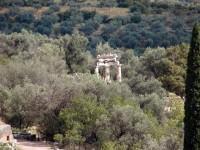
The Sanctuary of Athena Pronaia, the Τholos: The partly restored Tholos photographed among the olive-trees |
|
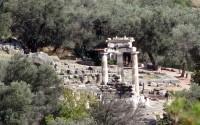
The Sanctuary of Athena Pronaia, the Τholos |
|
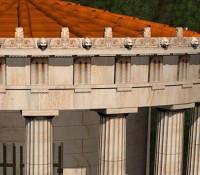
The Sanctuary of Athena Pronaia, the Τholos: Reconstruction of its exterior
Detail of the exterior of the Tholos of Athena Pronaia showing partial view of the single tier roof construction. Other models suggest that it was a two-tiered structure with a circular drum of marble, following the diameter of the interior space, rising through the first sloping roof and capped by a second conical roof, similar to the tholos at Epidauros. The large metopes of the exterior frieze have not been put in place.
credit: Greg Schultz, Coastal Carolina University, www.cipa.icomos.org/fileadmin/papers/Athens2007/ |
|
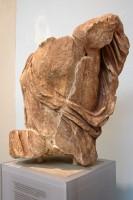
The sanctuary of Athena Pronaia, the Τholos: Upper torso of a female figure from an acroterion of the Tholos
It exhibits the gentle movement which characterizes all the sculptural decoration of the monument. The figure of Nike, with himation blowing in the wind, closely resembles similar sculptures from the Sanctuary of Asklepios at Epidauros. |
|
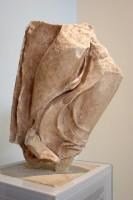
The sanctuary of Athena Pronaia, the Τholos: Lower torso of a female figure from an acroterion of the Tholos
It exhibits the gentle movement which characterizes all the sculptural decoration of the monument. The figure of Nike, with himation blowing in the wind, closely resembles similar sculptures from the Sanctuary of Asklepios at Epidauros. |
|
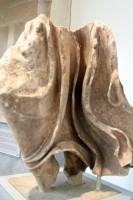
The sanctuary of Athena Pronaia, the Τholos: Lower torso of a female figure from an acroterion of the Tholos
Same exhibit as in the prevous photo |
|
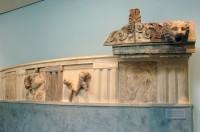
The Sanctuary of Athena Pronaia, the Τholos: The marble decoration of the doric peristyle of the Tholos
The partly restored entablature of the doric peristyle of the Tholos includes 4 metopes depicting the abduction of a woman by a centaur, a startled horse on its hind legs and a nude warrior mounting a horse. The poor condition of the metopes is due to the detachment of the relief figures and the use of the metopes as building material in the period of Late Antiquity. |
|
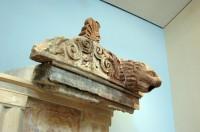
The Sanctuary of Athena Pronaia, the Τholos: The rain gutter protecting the exterior frieze
Part of the marble rain gutter around the edge of the Tholos roof |
|
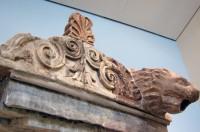
The Sanctuary of Athena Pronaia, the Τholos: The rain gutter protecting the exterior frieze
Part of the marble rain gutter around the edge of the Tholos roof. The relief decoration consists of acanthus, spiral shoots and inverted palmettes between lion's head spouts (480-470 BC.) |
|
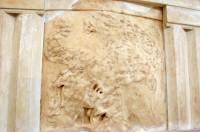
The Sanctuary of Athena Pronaia, the Τholos: Sculptures from the large metopes of the exterior frieze
The first of the four large metopes depicting the abduction of a woman by a centaur. |
|
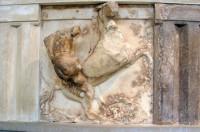
The Sanctuary of Athena Pronaia, the Τholos: Sculptures from the large metopes of the exterior frieze
The second of the large metopes of the Tholos, depicting the Amazonomachy (The battle against the Amazons). A nude man trying to control a startled horse. (480-470 BC.) |
|
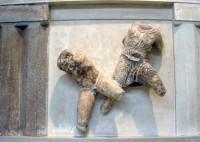
The Sanctuary of Athena Pronaia, the Τholos: Sculptures from the large metopes of the exterior frieze
The third one of the metopes, depicting the Amazonomachy (The battle against the Amazons). An Amazon is delivering a last blow to her already wounded opponent fallen onto his right knee (480-470 BC.) |
|
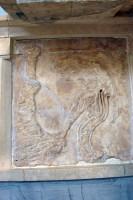
The Sanctuary of Athena Pronaia, the Τholos: Sculptures from the large metopes of the exterior frieze |
|
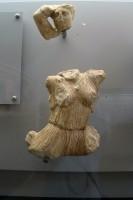
The sanctuary of Athena Pronaia, the Τholos: Sculptures detached from the metopes of the exterior frieze
1-2. Head and torso of an Amazon. She is wearing a pleated himation held fast around the waist and the breast by a ribon. (480-470 BC.) |
|
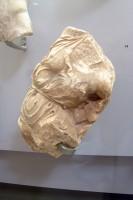
The sanctuary of Athena Pronaia, the Τholos: Sculptures detached from the metopes of the exterior frieze
14. Another torso of a fighting Amazon. (480-470 BC.) |
|
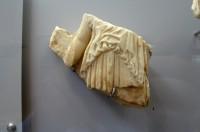
The sanctuary of Athena Pronaia, the Τholos: Sculptures from the small interior metopes of the Tholos
1. Fragment of a female figure wearing a pleated peplos with overfold. It retains part of the metope panel which most probably depicted a scene from the assembly of the gods. |
|
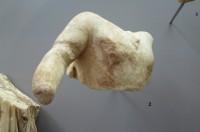
The sanctuary of Athena Pronaia, the Τholos: Sculptures from the small interior metopes of the Tholos
2. Upper torso of a (winged?) female figure, from a scene depicting the assembly of the gods. |
|
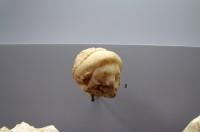
The sanctuary of Athena Pronaia, the Τholos: Sculptures from the small interior metopes of the Tholos
3. Female head with the hair braided and gathered in a sakkos (hairnet) |
|
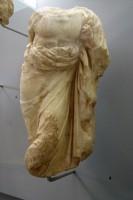
The sanctuary of Athena Pronaia, the Τholos: Sculptures from the small interior metopes of the Tholos
4. Headless male figure wearing a himation, with legs crossed in a relaxed pose. The figure is probably that of a deity from a scene depicting the assembly of the gods. |
|
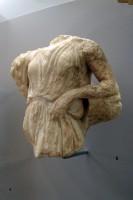
The sanctuary of Athena Pronaia, the Τholos: Sculptures from the small interior metopes of the Tholos
5. Torso of a female figure wearing a chiton with overfold, pinned at the shoulders. This figure, probably that of a deity from a scene depicting the assembly of the gods, is leaning with her left elbow on a small pillar. |
|
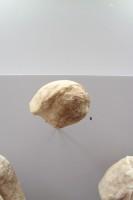
The sanctuary of Athena Pronaia, the Τholos: Sculptures from the small interior metopes of the Tholos
6. Upper part of a female head, most probably covered by a himation. |
|
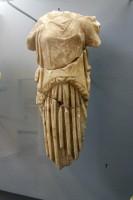
The sanctuary of Athena Pronaia, the Τholos: Sculptures from the small interior metopes of the Tholos
7. Torso of a standing female figure in hieratic pose, dressed in a peplos that forms a low pouch (kolpos) and is fastened at the shoulders with clasps. The figure is that of a deity from a scene depicting the assembly of the gods. |
|
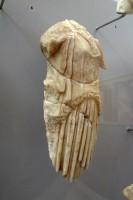
The sanctuary of Athena Pronaia, the Τholos: Sculptures from the small interior metopes of the Tholos
Same sculpture as in the previous photo |
|
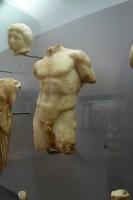
The sanctuary of Athena Pronaia, the Τholos: Sculptures from the small interior metopes of the Tholos
8. Head tilted toward the left shoulder.
9. Torso of nude male figure with a well-formed body, depicted motionless, at rest. |
|
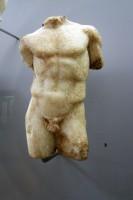
The sanctuary of Athena Pronaia, the Τholos: Sculptures from the small interior metopes of the Tholos
9. Torso of nude male figure with a well-formed body, depicted motionless, at rest. |
|
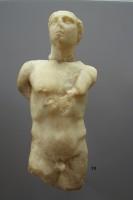
The sanctuary of Athena Pronaia, the Τholos: Sculptures from the small interior metopes of the Tholos
10. Torso of nude male figure with a well-formed body, depicted motionless, at rest. |
|
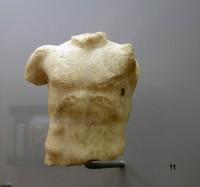
The sanctuary of Athena Pronaia, the Τholos: Sculptures from the small interior metopes of the Tholos
11. Upper torso of a nude male figure; exhibit Nr 10 is also partially visible. |
|
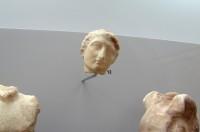
The sanctuary of Athena Pronaia, the Τholos: Sculptures from the small interior metopes of the Tholos
12. Male head with short curly hair |
|
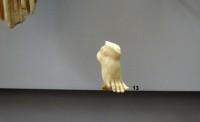
The sanctuary of Athena Pronaia, the Τholos: Sculptures from the small interior metopes of the Tholos
13. Fragment of the lower limb of a figure, displaying impressive detail in its rendering. |
|
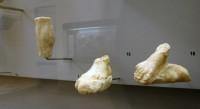
The sanctuary of Athena Pronaia, the Τholos: Sculptures from the small interior metopes of the Tholos
14-16. Fragments of the lower limbs of figures, displaying impressive variety and detail in their rendering. |
|
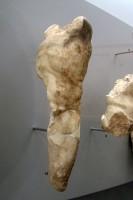
The sanctuary of Athena Pronaia, the Τholos: Sculptures from the small interior metopes of the Tholos
18. Male torso in vigorous motion with arms raised. The anatomical details and vividness of movement are rendered with plasticity. Possibly from a scene of some battle or heroic feat. |
|
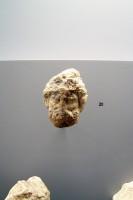
The sanctuary of Athena Pronaia, the Τholos: Sculptures from the small interior metopes of the Tholos
20. Head of a bearded figure. Attributed to a scene from the Trojan War on account of its likeness to the head of King Priam from the east pediment of the temple of Asclepius at Epidaurus. |
|
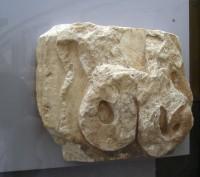
The sanctuary of Athena Pronaia, the Τholos: Sculptures from the small interior metopes of the Tholos
21. Part of a metope, its relief subject hammered off. The remnants of what appear to be tentacles have been associated with the Lernean Hydra and the respective labor of Heracles. |
|
|
Select Page of the Album:
|
|



